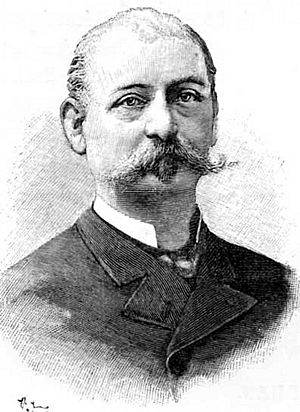Georges Henri Halphen facts for kids
Quick facts for kids
Georges-Henri Halphen
|
|
|---|---|
 |
|
| Born | 30 October 1844 Rouen, France
|
| Died | 23 May 1889 (aged 44) Versailles, France
|
| Nationality | French |
| Alma mater | École Polytechnique |
| Spouse(s) | Rose Marguerite Aron |
| Scientific career | |
| Fields | Mathematics |
| Thesis | Sur les invariants différentiels (1878) |
Georges-Henri Halphen (born October 30, 1844, in Rouen, France – died May 23, 1889, in Versailles, France) was a French mathematician. He was well-known for his work in geometry. This included enumerative geometry and the study of singularity theory for algebraic curves. He also explored invariant theory and projective differential geometry.
Life and Education
Georges-Henri Halphen studied at the École Polytechnique, a famous engineering school in France. He graduated in 1866. After that, he continued his education at another school, École d'Application de l'Artillerie et du Génie de Metz. He became a lieutenant in the Artillery.
In 1872, Halphen moved to Paris. There, he started teaching at the École Polytechnique. This is also when he began his important scientific research. He finished his main research paper, called a dissertation, in 1878.
In 1872, he married Rose Marguerite Aron. They had eight children together, four sons and four daughters. Three of their sons joined the military. One of his sons, Louis Halphen (1880-1950), became a French historian. Another son, Charles Halphen (1885-1915), was involved with the French Mathematical Society. His grandson, Étienne Halphen (1911–1954), later did important work in applied statistics.
Awards and Recognition
Georges-Henri Halphen received several important awards for his mathematical work. In 1880, he won the Steiner prize from the Prussian Academy of Sciences. He shared this award with another mathematician, Max Noether.
In 1881, Halphen received the Grand Prix from the Académie des sciences (French Academy of Sciences). This award was for his work on linear differential equations. He wrote a special paper about it called Mémoire sur la Reduction des Equations Différentielles Linéaires aux Formes Intégrales.
He also won the Prix Poncelet in 1883. In 1885, he received the Prix Petit d'Ormoy. In 1886, he was chosen to be a member of the Académie des sciences. He joined the Geometry section, taking the place of Jean Claude Bouquet. In 1887, Halphen was also elected to the Accademia dei Lincei in Rome, Italy.
Major Works
Georges-Henri Halphen's mathematical writings were collected and published in several volumes.
- Collected Works: His complete works, titled Oeuvres de G.H. Halphen, were published in four volumes. These were put together by famous mathematicians like Camille Jordan, Henri Poincaré, and Charles Émile Picard. They were published between 1916 and 1924.
- Treatise on Elliptic Functions: He also wrote a three-volume book called Traité des fonctions elliptiques et de leurs applications. This book was published in 1886, 1888, and 1891.
- The second volume talked about how elliptic functions could be used in physics, geometry, and the study of integrals.
- The third volume discussed their uses in algebra, especially with the quintic equation, and in number theory.
You can find a summary of Halphen's work by Laurent Gruson. A full list of his writings was also put together by Camille Jordan. This list was part of an article written after Halphen's death in the Journal de Mathématiques Pures et Appliquées.
See also
 In Spanish: Georges Henri Halphen para niños
In Spanish: Georges Henri Halphen para niños
- Bézout's theorem
- Cramer's paradox

